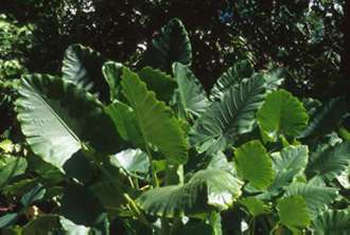
| Scientific
Name Colocasia Common Name Elephant's ear, Taro, Dasheen |
|
| Geophyte Organ: Tuber | ||||||||||||||||||||||
| Light Requirements: Full-AM Sun | ||||||||||||||||||||||
| Height: 36-84 inches (90-210 cm) | ||||||||||||||||||||||
| Flowering Season: Summer | ||||||||||||||||||||||
| Flower Color: Grown for green leaves | ||||||||||||||||||||||
| Planting Time: Spring | ||||||||||||||||||||||
| Planting Depth: Cover 4 inches (10 cm) | ||||||||||||||||||||||
| Spacing Between Tubers: 6 feet | ||||||||||||||||||||||
| Hardiness: Tender I - injured below 68°F (20°C) | ||||||||||||||||||||||
| Bulb Storage: Harvest tubers in fall, dry, and store at 70-75°F (21-23°C); does not tolerate temperature below 70°F (21°C) | ||||||||||||||||||||||
| Comments: Edible tuber; heavy feeders | ||||||||||||||||||||||
| Cultivars: Black Magic (60"; purple-black leaves), Illustris (30"; black leaves with green veins), Jet Black Knight | ||||||||||||||||||||||
USDA Hardiness Zones
C=container; H=hardy; M=hardy with mulch; Sp=plant spring, harvest fall; F=fall plant |
||||||||||||||||||||||
Elephant ear is the common name of several tropical plant species. Alocasia and Colocasia are two tropical plants often referred to as elephant ears. They are grown for their large and beautiful arrow/heart-shaped leaves. Colocasia leaves can grow to be two to three feet or longer. Alocasia leaves are known for their striking vein patterns.
Outside, elephant ear plants should be grown
in moist, fertile soil in partial shade and with high humidity. As a houseplant, they
require high humidity and a regular feeding program to encourage large leaves. They also
require a large space. Zone 7 is too cold in the winter to keep these tropical plants
outside. In the fall, just before the first frost, dig the plants, and cut off the tops.
Then store them in pots or bags for the winter at temperatures between 40 and 50 degrees
F; put dryish soil around the plant's roots. (I just leave them in their pots in the cool
basement and do not water.) The following spring, repot them at least 10 weeks before the
temperature rises to a tropical type of weather. Some of the Alocasia are smaller and make
more suitable houseplants, but they require high humidity and constant doses of plant
food. The bold, beautiful look of the larger and purple varieties has become very popular.
If the leaves are not moistened frequently, they can get spider mites.
Taken From
Country Living Gardner
ELEPHANT EARS
Colocasia esclenta
Start bulbs as soon as received, or keep in a dry, moderately cool frost-free place until ready to plant.
Start bulbs indoors first for best results, about 4 weeks before last frost. Place rounded side down on a thick layer of sphagnum or peat moss and barely cover. Put in warm place, 70-80°, to make growth start. Moisten occasionally to keep planting material slightly moist.
Pot singly in 6 to 8 inch pots as soon as shoots appear around the tops of the bulbs. Or plant two in 12" pots, space bulbs 6" apart. Use a mixture of 2/3 good garden soil and 1/3 peat moss or perlite. Place bulb in pot, firm soil and cover with 1/2 inch planting material. Water sparingly until plants are well rooted; then keep uniformly moist but not too wet. Keep pot in a warm place, protect from direct sunlight. Pots may then be sunk up to their rims in the garden after danger of frost and the weather and soil have become warm. Elephant Ears prefer a semishady, sheltered location and need to be kept well-watered.
Caladium bulbs may also be planted directly in the garden, 18 inches apart, without the headstart procedure, after all danger of frost in spring.
Before fall frost, dig the bulbs and allow
foliage to dry off. Cut stems back to about 1 inch above the bulbs. Spread bulbs in a dry,
frost-free place at about 60°. and cover with dry peat moss until ready to replant in
spring.
Taken From Burpee
Colocasia esculenta, taro, kalo. Herbaceous plant from old world tropics, with thick tuber (underground stem) containing much starch; cultivated for food for many centuries. Taro was brought to Hawaii by early migrating Polynesians as the main food source. They had perhaps 300 varieties taro under cultivation at one time. The leaves of many varieties were also eaten. Taro must be cooked to destroy the acrid crystals of calcium oxalate found in all parts of the plant. Taro was so important that it had great influence on the social and individual activities of the community. One obvious ramification of taro cultivation involved water utilization. Such was the importance of taro that it was considered the plant form (kino-lau) of the great god Kane, the giver of life.
Taken from Flowering Plant Families - UH Botany
Botony.com (an excellent site!)
Alocasia, Colocasia, Taro, Elephant Ear
